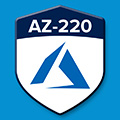Clientele ➞
























Duration: 4 Days
After completing this course, students will be able to:
Candidates for this exam should have subject matter expertise implementing the configuration
and coding tasks required to create and maintain the cloud and edge portions of an IoT
solution.
Responsibilities for this role include deploying physical devices, configuring and maintaining
them by using cloud services, and maintaining and troubleshooting the configuration
throughout the device lifecycle.
Azure IoT developers are also responsible for implementing design specifications for IoT
solutions, including device topology, connectivity, diagnostics and monitoring, and security.
These professionals develop and deploy modules and configure device networking for the Azure
IoT Edge portion of the solution. In addition to this, they implement designs for solutions to
manage data pipelines, including monitoring and data transformation as they relate to IoT.
Azure IoT developers work with architects, data engineers, and other stakeholders to ensure
successful business integration, including the implementation of the Azure Digital Twins service.
Candidates for this exam should have a general understanding of device types and Azure
services, including data storage options, data analysis, data processing, AI, and other platform as
a service (PaaS) options. They must be able to program in at least one Azure IoT software
development kit–supported (SDK–supported) language.
IoT Developers should have a good understanding of Azure services, including data storage options, data analysis, data processing, and the Azure IoT PaaS versus SaaS options. IoT Developers should have basic programming skills in at least one Azure-supported language, including C#, Node.js, C, Python, or Java.
Software Development Experience: Software development experience is a prerequisite for this course, but no specific software language is required, and the experience does not need to be at a professional level.
Data Processing Experience: General understanding of data storage and data processing is recommended but not required.
Cloud Solution Awareness: Students should have a basic understanding of PaaS, SaaS, and IaaS implementations. Microsoft Azure Fundamentals (AZ-900), or equivalent skills, is recommended.
Set up an IoT Hub Device Provisioning Service (DPS)
Deploy an IoT Edge device
Integrate with upstream and downstream systems
Configure message routing in Azure IoT Hub
Implement security for IoT devices and services
The trainer will be Microsoft Azure Professional.
$2500/-
Our Partners
